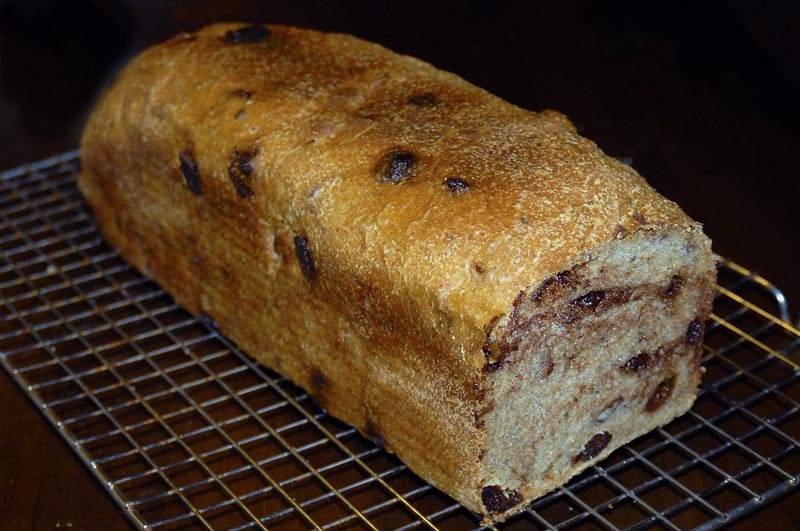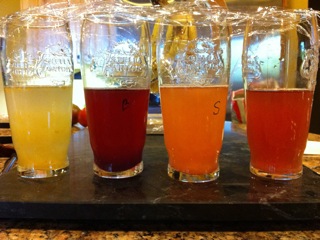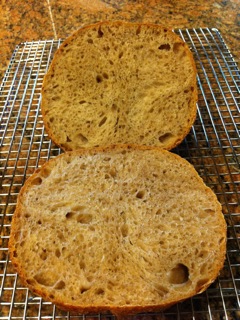 I love cherries and I love vanilla, so what better flavor combination to try to work into a bread recipe? I have never incorporated a liquor into a bread dough before, so I'm not sure what to expect, but I do have to say it smelled fantastic mixing it up.
I love cherries and I love vanilla, so what better flavor combination to try to work into a bread recipe? I have never incorporated a liquor into a bread dough before, so I'm not sure what to expect, but I do have to say it smelled fantastic mixing it up.
I started by taking my 65% hydration AP flour starter and building enough starter for 15 ounces of levain for the finished dough. I wanted to incorporate some white rye into the starter to give it a little rye flavor so I added 22% white rye flour to the levain build along with AP flour and some water to make a 67% hydration starter.
The final dough including the starter has a hydration level of 66%. I wanted to try to make this a moist and delicate crumb so I incorporated a large percentage of French Style low protein flour from KAF, along with a small percentage of white rye and durum flour. After finishing the loaf in the oven and tasting it, I have decided that I added a little too much of the Cherry Marnier and vanilla so I have adjusted the amount in the recipe below. This is a perfect bread for french toast or bread pudding or just as toast with some butter or cheese.
Starter Ingredients
7 ounces All Purpose Flour (I use KAF)
2 ounces White Rye Flour
6 ounces Water (90 degrees)
.75 ounces Starter, 65% Hydration (you can adjust the water to suit your current hydration level)
Final Dough
15 ounces Levain from above (75% Bakers Percentage)
12.6 ounces French Style Flour (80% Bakers Percentage)
3.4 ounces White Rye Flour (10% Bakers Percentage)
4 ounces Durum Semolina Flour (10% Bakers Percentage)
9.5 oz. water (90 degrees F.) (47.5% Bakers Percentage)
.5 ounce Pure Vanilla Extract (.03% Bakers Percentage)
3 ounces Cherry Marnie (15%)
2 1/2 Teaspoons, .63 ounces Sea Salt (3.2% Bakers Percentage)
Bakers % Final Dough
White Rye Flour 4 ounces
AP Flour 7 ounces
French Style 16 ounces
Durum 2 ounces
Total Flour 29 ounces 100%
Salt .63 ounces 2.1%
All Liquids 19 ounces 66%
Directions
Using your stand mixer or by hand, mix the water with the starter to break up the starter.
Add the flours and vanilla extract and Cherry Marnier and mix on the lowest speed for 2 minutes. Let rest for 15 minutes - 20 minutes to allow the gluten to develop.
Next, add the salt and mix for 4 minutes more on medium speed, adding more flour if necessary to produce a slightly sticky ball of dough.
Remove dough to your lightly floured work surface and need for 1 minute and form a ball.
Leave uncovered for 15 minutes.
Do a stretch and fold and form into a ball again and cover with a clean moist cloth or oiled plastic wrap.
Let the dough rest another 10-15 minutes and do a stretch and fold again. Let it rest for an additional 15 minutes and do 1 more stretch and fold. After this last stretch and fold cover the bowl again and let it rest at room temperature for 1.5 to 2 hours and then put it in your refrigerator overnight or up to 3 days.
When ready to bake the bread, take the bowl out of your refrigerator and let it rest at room temperature for 2 hours. After 2 hours shape the dough as desired being careful not to handle the dough too roughly so you don't de-gas it. Place it in your bowl, banneton or shape into baguettes.
Let it sit at room temperature for 2 hours covered with oiled plastic wrap or a wet cloth.
Pre-heat oven with baking stone (I use one on bottom and one on top shelf of my oven), to 500 degrees F.
Slash loaves as desired and place empty pan in bottom shelf of oven.
Pour 1 cup of very hot water into pan and place loaves into oven.
Lower oven to 450 Degrees and bake for 25 - 35 minutes until bread is golden brown and internal temperature reaches 200 degrees.
Let cool on cooling rack and enjoy!
The final dough had a nice open crumb and crispy crust. The overall dough did not rise as much as I would have liked, but the oven spring was excellent. Next time I think I would add some dried cherries and maybe some walnuts to kick it up a bit.
























































